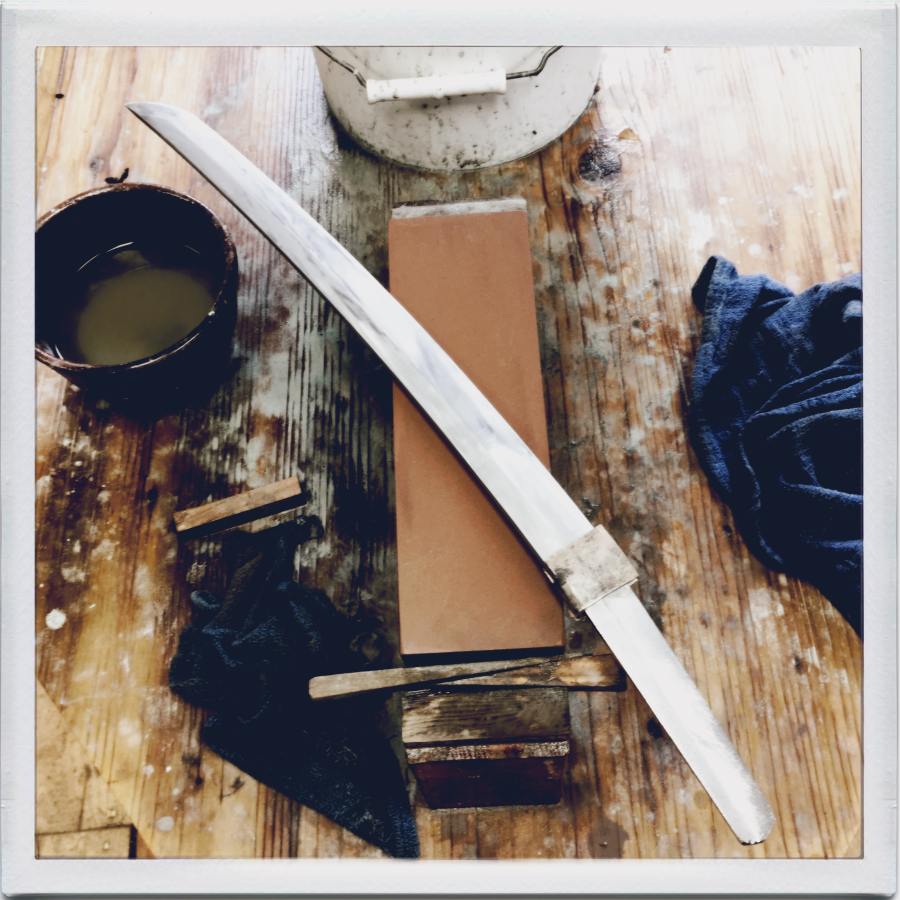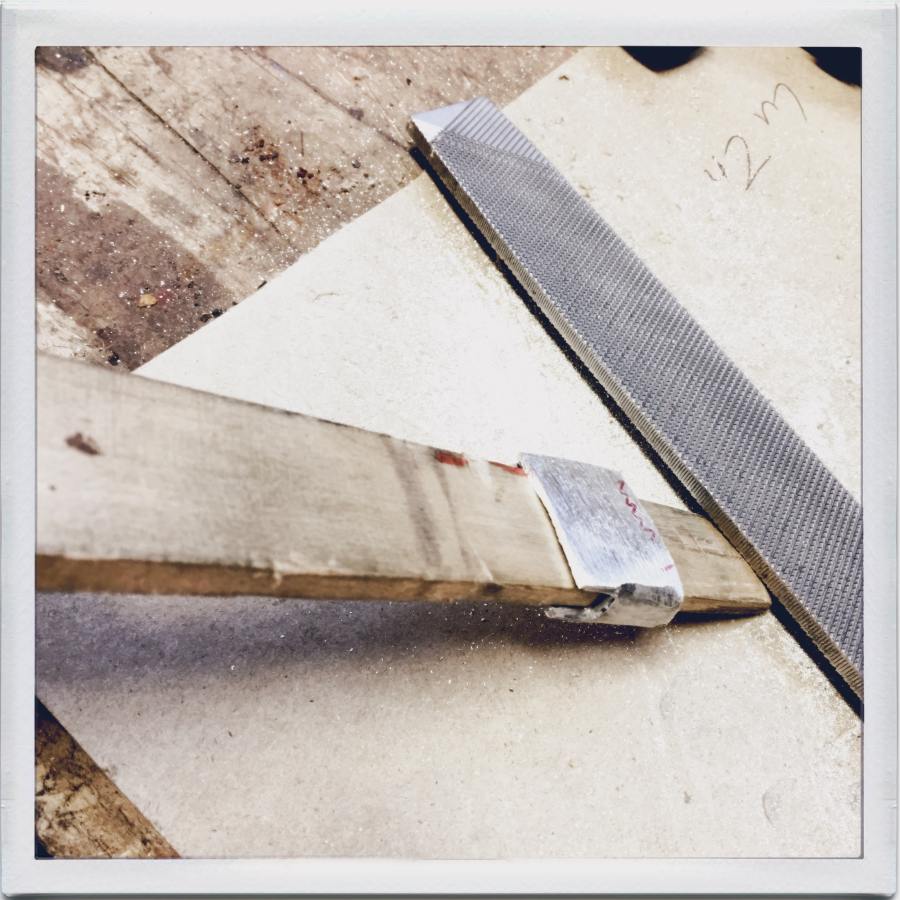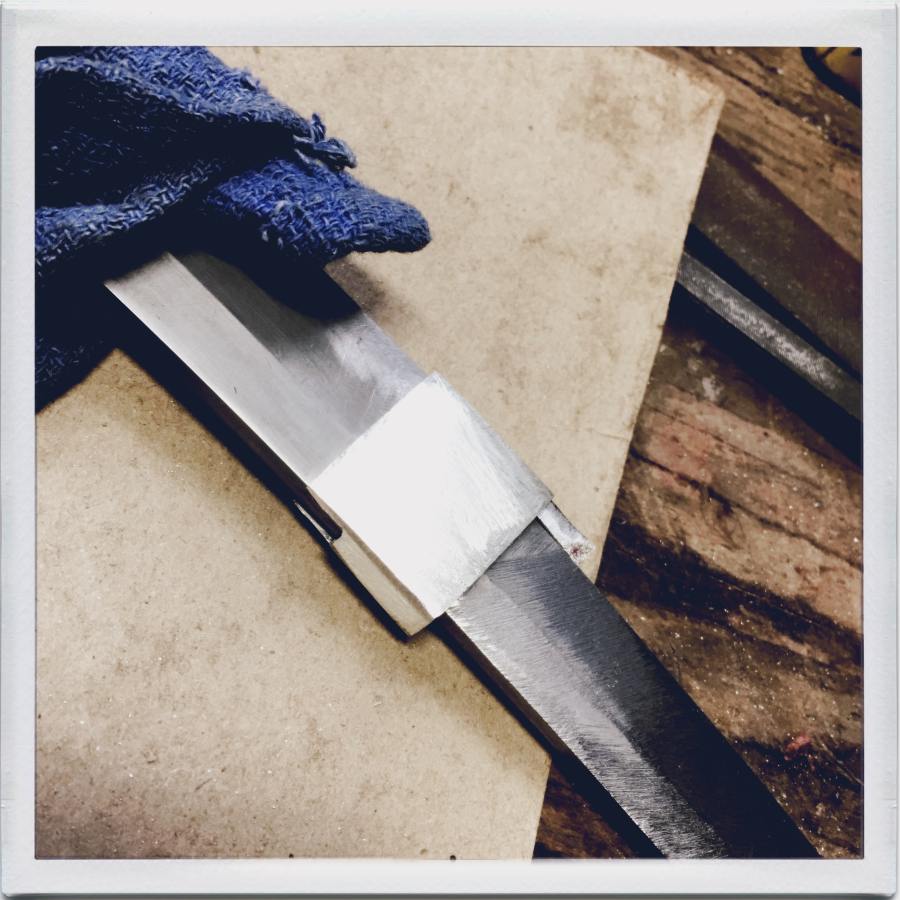Some important things:
Samson is fine.

I can’t tell if he remembers me and still likes me, or had forgotten me and decided he likes me (all over again). Either way, I feel blessed by dog.
This time of year there are lovely-looking wild raspberries and blackberries, too:

I launched the drone and got some cool(ish) fly-aways, though I had to be extremely agile about take-off and shut-down because Bear, a cattle dog, was un-fond of drones and wanted to chase it off. I didn’t want any dog to get its muzzle munched by a flying table-saw, so I had to try to explain to a dog that does not recognize me as a proper authority. You’ve got to respect a dog like that, especially when you’re a guest in their territory. The situation resolved fortuitously.
Back to work:

More grinding!
The habaki is test-fitted just to see how it looks; later in the day it gets some delicate whacking to form it around the blade and then it’s ready for shaping. The morning, however is spent grinding – or, depending on how you see it – moving scratches around on the blade.
It is interesting how the different angles of grinding change the color of the steel; sometimes the temper-line (hamon) really pops out, and other times the blade looks like a stick of gray putty. It depends on the light and the angle, as well as how wet the blade is, and how much ground stone is slurried onto it. Eventually I learn not to freak out if the sword suddenly looks terrible – a wipe with a towel or a paper towel and it’ll all be back to normal in a flash.
The morning and early afternoon are spent grinding. Eventually I pull out my phone and queue up The Bee Gees Greatest Hits, which seems to be very good music to grind to.
After lunch we switch to shaping the habaki, once the area that is going to be underneath it is scratch-free and won’t change dimensions any more (not more than a few 10,000ths of an inch) In proper Japanese fashion, the process is all manual. That’s at least partly because the habaki are silver and if we take them onto a belt sander, valuable silver dust will be lost. My second theory is that with hand tools it’s a lot harder to completely screw things up quickly. Slow-moving disasters can be headed off and avoided, but a belt sander can create a thorough disaster in a fraction of a second. So, I file.

The habaki is tapered front to back, and is curved top to bottom but flat on the bevels. In other words it’s sort of blade-shaped except that it’s not; the dimensions are different and so is the taper – but it needs to match and echo the shape of the blade. This is a very Japanese thing, harmonious vagueness “I’ll know it’s right when I see it” but, by golly, it really is obvious.
After lunch we take a break for some ‘show and tell’ and a chance to look at a double habaki that Michael Bell made: a habaki made of shakudo that has another habaki of its own out of gilded shakudo. The fit is impressive; it is also a very Japanese thing to make something like that by hand, for no other reason than that it would harmonize correctly with the blade.
Then we go back to our own awkward-looking efforts, and cringe a bit.

Silver moves pretty easily, though, and pretty soon my habaki is starting to look like it belongs there. The thicknesses at the front and back are even, the bevels are flat horizontally and curved vertically and I have not jammed my thumb onto the cutting edge. During the course of grinding the scratches out of the blade, it has begun to become sharp. It’s already as sharp as most people’s cooking knives, but it’s nowhere near what it promises to be. (And look at that hint of temper-line peeking out in front of the habaki!)
Look at the blade-edge of the habaki and you’ll see a matchstick-shaped piece of silver that was cut off to use as filler at the bottom where the ends fold together. I had to shape and file that into a little silver wedge that fits exactly behind the lip of the sword’s edge and the contact-point where the habaki comes together. Tomorrow’s first agenda item is to tighten the metal with some steel wires, fit the wedge in, and braze the piece together. Then: more filing, eventually fine-shaping, and polishing.
I have become a polishing machine.

Gabriel Bell makes pickled beets. Why have I never encountered these before? When I get home I am going to see if I can do anything in the pickled garlic chili beet department – sort of beet kimchi. What can possibly go wrong?

The knife that I have made for my fathers 50th birthday was made mostly on stones, althought I gave it final polish with wet and dry sand paper because I did not have stones that fine. I remember that my finger did hurt after a while and I had to take breaks for that. That and the finger wrinkles.
I love my belt grinder, but I will probably splurge on a set of grinding and polishing stones anyway, for more “refined” works. I hope to make at least a tanto once in my life.
That is great – yeah, I like slow myself. There are times when I want to go fast, but slow is good.
Also, kudos on stopping the dog from getting the drone. That must have been at least as challenging as all this grinding.